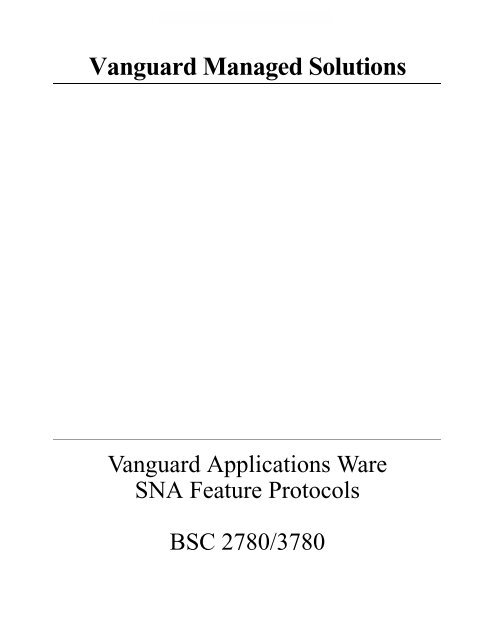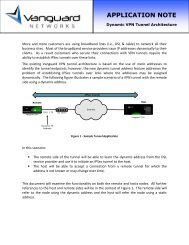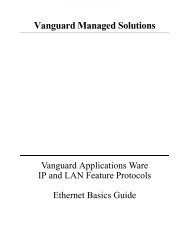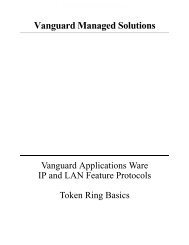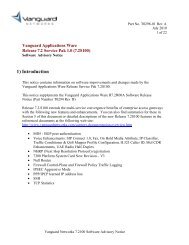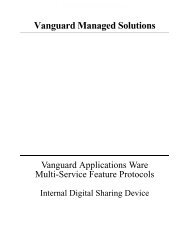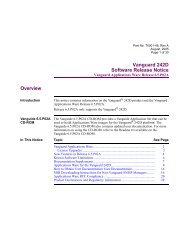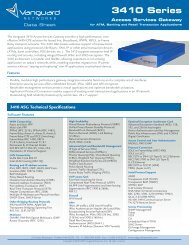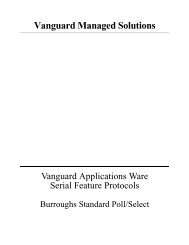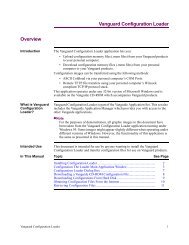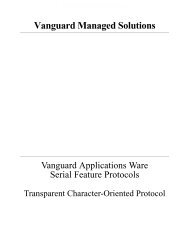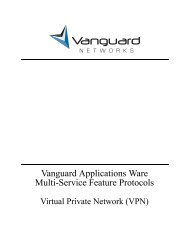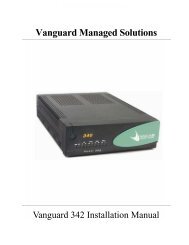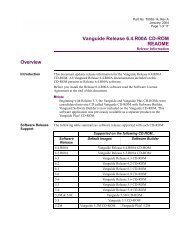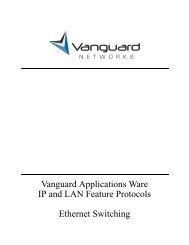BSC 2780/3780 Protocol - Vanguard Networks
BSC 2780/3780 Protocol - Vanguard Networks
BSC 2780/3780 Protocol - Vanguard Networks
Create successful ePaper yourself
Turn your PDF publications into a flip-book with our unique Google optimized e-Paper software.
<strong>Vanguard</strong> Managed Solutions<br />
<strong>Vanguard</strong> Applications Ware<br />
SNA Feature <strong>Protocol</strong>s<br />
<strong>BSC</strong> <strong>2780</strong>/<strong>3780</strong>
Notice<br />
©2003 <strong>Vanguard</strong> Managed Solutions, LLC<br />
575 West Street<br />
Mansfield, Massachusetts 02048<br />
(508) 261-4000<br />
All rights reserved<br />
Printed in U.S.A.<br />
Restricted Rights Notification for U.S. Government Users<br />
The software (including firmware) addressed in this manual is provided to the U.S.<br />
Government under agreement which grants the government the minimum Òrestricted rightsÓ<br />
in the software, as defined in the Federal Acquisition Regulation (FAR) or the Defense<br />
Federal Acquisition Regulation Supplement (DFARS), whichever is applicable.<br />
If the software is procured for use by the Department of Defense, the following legend<br />
applies:<br />
Restricted Rights Legend<br />
Use, duplication, or disclosure by the Government<br />
is subject to restrictions as set forth in<br />
subparagraph (c)(1)(ii) of the<br />
Rights in Technical Data and Computer Software<br />
clause at DFARS 252.227-7013.<br />
If the software is procured for use by any U.S. Government entity other than the Department<br />
of Defense, the following notice applies:<br />
Notice<br />
Notwithstanding any other lease or license agreement that may pertain to,<br />
or accompany the delivery of, this computer software, the rights of the<br />
Government regarding its use, reproduction, and disclosure are as set forth<br />
in FAR 52.227-19(C).<br />
Unpublished - rights reserved under the copyright laws of the United States.
Notice (continued)<br />
Proprietary Material<br />
Information and software in this document are proprietary to <strong>Vanguard</strong> Managed Solutions,<br />
LLC (or its Suppliers) and without the express prior permission of an officer, may not be<br />
copied, reproduced, disclosed to others, published, or used, in whole or in part, for any<br />
purpose other than that for which it is being made available. Use of software described in this<br />
document is subject to the terms and conditions of the Software License Agreement.<br />
This document is for information purposes only and is subject to change without notice.<br />
Part No. T0101-02, Rev G<br />
Publication Code DS<br />
First Printing August 1994<br />
Manual is current for Release 6.2 of the <strong>Vanguard</strong> Applications Ware.<br />
To comment on this manual, please send e-mail to LGEN031@vanguardms.com
<strong>BSC</strong> <strong>2780</strong>/<strong>3780</strong><br />
Overview<br />
Introduction<br />
Before You Use<br />
This Manual<br />
Related<br />
Documentation<br />
This manual describes the IBM <strong>BSC</strong> <strong>2780</strong>/<strong>3780</strong> option for the <strong>Vanguard</strong> products<br />
and is part of the SNA Feature <strong>Protocol</strong>s Manual.<br />
The IBM <strong>BSC</strong> <strong>2780</strong>/<strong>3780</strong> option lets <strong>BSC</strong> <strong>2780</strong>/<strong>3780</strong> devices use <strong>Vanguard</strong> nodes to<br />
communicate with other <strong>2780</strong>/<strong>3780</strong> devices over X.25 or Frame Relay networks.<br />
Some knowledge of the IBM <strong>2780</strong>/<strong>3780</strong> <strong>BSC</strong> protocol is required to implement the<br />
<strong>BSC</strong> <strong>2780</strong>/<strong>3780</strong> option on your node.<br />
• <strong>Vanguard</strong> Configuration Basics Manual (Part Number T0113)<br />
• <strong>Vanguard</strong> Basic <strong>Protocol</strong>s Manual (Part Number T0106)<br />
• General Information - Binary Synchronous Communications from the IBM<br />
Systems Reference Library (IBM number TP-09, Order No.-GA27-3004-2)<br />
Alarms & Reports<br />
Refer to the <strong>Vanguard</strong> Applications Ware Alarms and Reports Manual (Part Number<br />
T0005) for details on alarms and reports generated by the <strong>BSC</strong> <strong>2780</strong>/<strong>3780</strong> option.<br />
In This Manual Topic See Page<br />
About the <strong>BSC</strong> <strong>2780</strong>/<strong>3780</strong>............................................................................. 2<br />
<strong>BSC</strong> <strong>2780</strong>/<strong>3780</strong> Operation ............................................................................ 4<br />
<strong>BSC</strong> <strong>2780</strong>/<strong>3780</strong> PAD Port......................................................................... 8<br />
X.25 Connection ....................................................................................... 10<br />
801 Autodialer........................................................................................... 11<br />
Configurations Supported.............................................................................. 12<br />
<strong>BSC</strong> <strong>2780</strong>/<strong>3780</strong> Configuration and V.25 bis Emulation ........................... 13<br />
Configuration and Administration................................................................. 14<br />
<strong>BSC</strong> <strong>2780</strong>/<strong>3780</strong> Configuration Parameters............................................... 16<br />
801 Autodialer Port Configuration................................................................ 24<br />
801 Autodialer (RS366) Parameters ......................................................... 25<br />
Statistics......................................................................................................... 26<br />
Detailed Port Statistics .............................................................................. 27<br />
RS366 Port Statistics................................................................................. 31<br />
SNMP MIB Support for EIA Monitoring ..................................................... 32<br />
<strong>BSC</strong> <strong>2780</strong>/<strong>3780</strong> 1
About the <strong>BSC</strong> <strong>2780</strong>/<strong>3780</strong><br />
About the <strong>BSC</strong> <strong>2780</strong>/<strong>3780</strong><br />
Introduction<br />
Features<br />
<strong>BSC</strong> <strong>2780</strong>/<strong>3780</strong><br />
Connectivity<br />
This section describes the characteristics of the IBM <strong>BSC</strong> <strong>2780</strong>/<strong>3780</strong> protocol option<br />
for <strong>Vanguard</strong> Products.<br />
The <strong>BSC</strong> <strong>2780</strong>/<strong>3780</strong> feature provides the capability to transfer data between two<br />
devices via an X.25 or Frame Relay network. It is a peer-to-peer protocol. <strong>Vanguard</strong><br />
products use a full-duplex, point-to-point circuit, as the physical transmission path.<br />
The <strong>BSC</strong> <strong>2780</strong>/<strong>3780</strong> option supports:<br />
• Access for IBM Binary Synchronous Communication (<strong>BSC</strong>) <strong>2780</strong>/<strong>3780</strong><br />
devices to a <strong>BSC</strong> host or other <strong>BSC</strong> <strong>2780</strong>/<strong>3780</strong> devices and emulators<br />
• Local <strong>BSC</strong> acknowledgment to reduce network delay<br />
• 801 Autodialer Emulation to eliminate the need for an external 801<br />
Autodialer which reduces line costs and long-distance charges<br />
• V.25 bis Emulation to allow a <strong>BSC</strong> <strong>2780</strong> port to originate calls using the<br />
Packet Switched Network address of the destination <strong>BSC</strong> <strong>2780</strong> port<br />
• Data integrity provided by a proprietary transport layer protocol<br />
• Low network delay of messages<br />
• Session integrity provided by a proprietary session layer protocol<br />
• Support for the full and half duplex modem emulation (EMRI)<br />
• Handling of the RI EIA signal to wake up the scanner (EMRI)<br />
• Idle Disconnect Timer starts when the PAD receives an EOT from the device<br />
(Idle Disconnect Timer)<br />
• Non-spoofing mode (ACK)<br />
• PAD not sending a TTD control character (NOTTD)<br />
• Passing of the initial line bid/response with the host/terminal ID to the remote<br />
device (TID)<br />
• Connection to full and half duplex modem (DIMO)<br />
<strong>BSC</strong> <strong>2780</strong>/<strong>3780</strong> is typically used to connect <strong>BSC</strong> <strong>2780</strong>/<strong>3780</strong> devices while using a<br />
proprietary Session/Transport mechanism over a network.<br />
The <strong>BSC</strong> <strong>2780</strong> feature also allows for connection to a ZENGIN or JCA terminal, and<br />
NCR or ICL scanner, through a <strong>BSC</strong> <strong>2780</strong> device.<br />
The ZENGIN and JCA protocols are the control character level subset of IBM <strong>2780</strong>.<br />
The ZENGIN protocol does not have the TTD and RVI control characters, and the<br />
JCA protocol does not have an ETB control character. Also, the half- or full-duplex<br />
modem is used in the network configuration to connect to the PSTN (Public<br />
Switched Telephone Network).<br />
The NCR and ICL scanners have a unique line bid and response sequence. This<br />
consists of ENQ with the host name, and ACK with the store number. Also, the RI<br />
(ring indicator) EIA signal is used to wake up the NCR scanner.<br />
2 <strong>BSC</strong> <strong>2780</strong>/<strong>3780</strong>
About the <strong>BSC</strong> <strong>2780</strong>/<strong>3780</strong><br />
Interface Line<br />
Characteristics<br />
Platform Support<br />
Synchronous<br />
Device Support<br />
The <strong>BSC</strong> <strong>2780</strong>/<strong>3780</strong> interface line support includes:<br />
• Compatibility with IBM <strong>BSC</strong> <strong>2780</strong>/<strong>3780</strong> protocol<br />
• Peer-to-peer communication<br />
• Full-duplex support (EIA control only − data transfer is always half-duplex)<br />
• Half-duplex support for EIA control of half-duplex modems<br />
• X.25/Frame Relay compatibility with all <strong>Vanguard</strong> Products and other X.25/<br />
Frame Relay products<br />
• Use of ASCII and EBCDIC code sets<br />
• Internal/External clocking<br />
• 1200 to 80 Kbps, including 64 Kbps rate<br />
• Low network delay<br />
• Transparent text support<br />
The <strong>BSC</strong> <strong>2780</strong>/<strong>3780</strong> option is supported on all <strong>Vanguard</strong> platforms.<br />
The <strong>BSC</strong> <strong>2780</strong>/<strong>3780</strong> option supports these IBM Front End Processors (FEPs)<br />
controlling IBM <strong>2780</strong>/<strong>3780</strong> devices:<br />
• 3705<br />
• 3720<br />
• 3725<br />
• 3745<br />
These terminal devices are also supported:<br />
• Any IBM <strong>2780</strong>/<strong>3780</strong> device<br />
• AST <strong>3780</strong>, AST Research, Inc., Irvine, California, 92714–4992<br />
• ZENGIN or JCA terminal, and NCR or ICL scanners<br />
Mainframe Sites<br />
Supporting Remote<br />
Devices<br />
Mainframe sites that support the <strong>BSC</strong> <strong>2780</strong>/<strong>3780</strong> protocol for remote devices may<br />
have different configurations of hardware and applications software; yet the<br />
<strong>BSC</strong> <strong>2780</strong>/<strong>3780</strong> support requirements remain constant, with only minor exceptions.<br />
<strong>BSC</strong> <strong>2780</strong>/<strong>3780</strong> 3<br />
T0101-02, Revision G Release 6.2
<strong>BSC</strong> <strong>2780</strong>/<strong>3780</strong> Operation<br />
<strong>BSC</strong> <strong>2780</strong>/<strong>3780</strong> Operation<br />
What Is It?<br />
The <strong>BSC</strong> <strong>2780</strong>/<strong>3780</strong> option is a software feature that gives <strong>Vanguard</strong> products the<br />
capability of passing data traffic between two <strong>BSC</strong> <strong>2780</strong>/<strong>3780</strong> devices. Because of<br />
its point-to-point nature, the <strong>BSC</strong> <strong>2780</strong>/<strong>3780</strong> option can only support one device on<br />
each line. Figure 1 shows a typical <strong>2780</strong>/<strong>3780</strong> application.<br />
IBM Host<br />
IBM Front-End<br />
Processor<br />
DCE (Modem)<br />
• • • ••<br />
<strong>BSC</strong> <strong>2780</strong>/<strong>3780</strong> Line<br />
DCE (Modem)<br />
• • • ••<br />
Printer Card Reader<br />
<strong>BSC</strong> <strong>2780</strong>/<strong>3780</strong><br />
Device<br />
Figure 1. Typical IBM <strong>BSC</strong> <strong>2780</strong>/<strong>3780</strong> Environment<br />
How <strong>BSC</strong> <strong>2780</strong>/<br />
<strong>3780</strong> Passes Data<br />
Traffic<br />
How ACKs Work<br />
<strong>BSC</strong> <strong>2780</strong>/<strong>3780</strong> is called a peer-to-peer protocol because either side may initiate data<br />
transfer by bidding for the line. Line bidding is performed by issuing an Enquiry<br />
(ENQ) character. All transmissions are preceded by a pair of Synchronization (SYN)<br />
characters. If the receiver is ready, it responds with the first Acknowledgment<br />
(ACK 0).<br />
Once the receiver confirms that communications may begin, the sender transmits<br />
data, beginning with a Start of Text (STX) character, in the following format:<br />
STX Text ETB CRC1 CRC2<br />
The last block of text in a transmission cycle uses an End-of-Text (ETX) character in<br />
place of the End-of-Text-Block (ETB) character along with the Cyclical Redundancy<br />
Check (CRC) 1 and 2.<br />
If the data is properly received, the receiver responds with alternating ACK 1 and<br />
ACK 0 sequences. The first text message receives ACK 1. If an error is detected<br />
(invalid CRC characters), the receiver responds with Negative Acknowledgment<br />
(NAK). The sender should then retransmit the original data block which had the<br />
error. ACK 0 and ACK 1 transmission carries forward from the point at which it had<br />
left off. If too many transmission errors occur, the sender or the receiver may abort<br />
the sequence by sending End of Transmission (EOT) instead of text retransmission<br />
or NAK.<br />
If the receiver has text to send to the transmitter, it may replace an ACK 0 or ACK 1<br />
with a Reverse Interrupt (RVI). The sender may either terminate its transmission, or<br />
continue sending its text.<br />
4 <strong>BSC</strong> <strong>2780</strong>/<strong>3780</strong>
<strong>BSC</strong> <strong>2780</strong>/<strong>3780</strong> Operation<br />
Enquiry<br />
Wait for<br />
Acknowledgment<br />
Temporary Text<br />
Delays<br />
End of Text<br />
Example of<br />
Passing Data<br />
Traffic<br />
If the transmitter receives no response to its text after a configurable timeout period<br />
(three seconds on standard IBM equipment), it issues an ENQ response. Upon<br />
receipt of the ENQ, the receiver repeats its last protocol sequence (either ACK 1 or<br />
ACK 0). Based on which sequence it receives, the transmitter can determine whether<br />
the timeout was due to the receiver not recognizing the last data block, or the<br />
transmitter not recognizing the last protocol sequence. The transmitter may then<br />
either retransmit the last block, or continue with the next one accordingly.<br />
The receiver may flow control the transmitter by issuing a Wait for Acknowledgment<br />
(WACK) sequence in response to text. For maximum efficiency, the receiver should<br />
postpone this transmission for a time period just shorter than the ENQ timer<br />
mentioned earlier. After this timeout, the transmitter sends another ENQ in order to<br />
contend for the channel a second time. The receiver may then either keep waiting<br />
and sending a WACK, or resume data flow by sending the proper acknowledgment<br />
sequence.<br />
If the transmitter does not have the next data to be sent immediately available, it may<br />
stall the line by sending periodic Temporary Text Delay (TTD) sequences. The<br />
receiver responds with NAK to these sequences, but does not count them as line<br />
errors. As with the WACK sequence in the previous paragraph, there should be a<br />
short delay between each TTD sequence.<br />
When all data has been transmitted, the transmitter closes the transmission cycle by<br />
issuing EOT. Either side may then take control of the line by bidding with ENQ as<br />
described above.<br />
The IBM FEP or the <strong>2780</strong>/<strong>3780</strong> device must bid for the line to be able to transfer<br />
data.<br />
For example, if you put a stack of cards in a card reader, the device sends ENQ to<br />
prepare the host to receive data. Figure 2 shows how data traffic passes between two<br />
<strong>BSC</strong> <strong>2780</strong>/<strong>3780</strong> devices.<br />
IBM Front-End<br />
Processor<br />
ENQ<br />
ACK0<br />
Message 1<br />
ACK1<br />
Message 2 (corrupted)<br />
NAK<br />
Resend Message 2<br />
ACK0<br />
Last Message<br />
ACK1<br />
EOT<br />
Printer Card Reader<br />
<strong>BSC</strong> <strong>2780</strong>/<strong>3780</strong><br />
Device<br />
Figure 2. Typical IBM <strong>BSC</strong> <strong>2780</strong>/<strong>3780</strong> Line Operation<br />
<strong>BSC</strong> <strong>2780</strong>/<strong>3780</strong> 5<br />
T0101-02, Revision G Release 6.2
<strong>BSC</strong> <strong>2780</strong>/<strong>3780</strong> Operation<br />
Example of a Busy<br />
Network<br />
If the host is not ready when the ENQ is received, it can respond with WACK.<br />
A NAK can be sent by the host to discontinue the request.<br />
Figure 3 shows a typical busy network. A terminal or host may also be busy for an<br />
indefinite period of time.<br />
IBM Front-End<br />
Processor<br />
Message<br />
WACK<br />
ENQ<br />
pause<br />
Printer Card Reader<br />
WACK<br />
ENQ<br />
ACK0<br />
pause<br />
<strong>BSC</strong> <strong>2780</strong>/<strong>3780</strong><br />
Device<br />
Figure 3. IBM <strong>BSC</strong> <strong>2780</strong>/<strong>3780</strong> Communication With Occupied Host<br />
V.25 bis V.25 bis lets a <strong>BSC</strong> <strong>2780</strong> port originate calls using the Packet Switched Network<br />
address of the destination <strong>BSC</strong> <strong>2780</strong> port. This lets a <strong>BSC</strong> <strong>2780</strong> port access all other<br />
<strong>BSC</strong> <strong>2780</strong> ports on the PSN without reconfiguring the port. The V.25 bis<br />
implementation is a subset of the CCITT 1988 recommendation for V.25 bis for<br />
mode 108/2.<br />
Zengin or JCA<br />
Terminal<br />
Application<br />
A typical application that uses the <strong>BSC</strong> <strong>2780</strong> protocol could include a ZENGIN or<br />
JCA terminal connected to a <strong>Vanguard</strong> unit <strong>BSC</strong> <strong>2780</strong> TPAD port either directly or<br />
via modem. This <strong>Vanguard</strong> port, in turn, is connected through switched virtual<br />
circuits over an X.25 network to another <strong>Vanguard</strong> unit with a <strong>BSC</strong> <strong>2780</strong> HPAD port,<br />
and then connected to another ZENGIN or JCA terminal either directly or via a<br />
modem, as shown in Figure 4. You could also have a similar application using a<br />
Frame Relay network in place of the X.25 network.<br />
ZENGIN<br />
Host<br />
JCA<br />
Host<br />
M<br />
M<br />
PDN<br />
PDN<br />
M<br />
M<br />
<strong>BSC</strong> <strong>2780</strong><br />
<strong>BSC</strong> <strong>2780</strong><br />
6525<br />
6520<br />
X.25<br />
X.25<br />
X.25<br />
6525<br />
6520<br />
6525<br />
6520<br />
<strong>BSC</strong> <strong>2780</strong><br />
M<br />
M<br />
PDN<br />
PDN<br />
M<br />
M<br />
ZENGIN<br />
ZENGIN<br />
JCA<br />
JCA<br />
<strong>BSC</strong> <strong>2780</strong><br />
Figure 4. <strong>BSC</strong> <strong>2780</strong> Application Environment (ZENGIN or JCA)<br />
6 <strong>BSC</strong> <strong>2780</strong>/<strong>3780</strong>
<strong>BSC</strong> <strong>2780</strong>/<strong>3780</strong> Operation<br />
NCR or ICL<br />
Scanner<br />
Application<br />
Another typical application using <strong>BSC</strong> <strong>2780</strong> includes an NCR or ICL scanner<br />
connected to a <strong>Vanguard</strong> device <strong>BSC</strong> <strong>2780</strong> TPAD port. This, in turn, is connected<br />
through switched virtual circuits over an X.25 network to another <strong>Vanguard</strong> device<br />
with a <strong>BSC</strong> <strong>2780</strong> HPAD port, and then connected to the IBM host. This<br />
configuration is shown in Figure 5. You could also have a similar application using a<br />
Frame Relay network in place of the X.25 network.<br />
Host<br />
<strong>Vanguard</strong> HPAD<br />
801 Autodialer Emulator<br />
<strong>Vanguard</strong> TPAD Node<br />
<strong>BSC</strong> <strong>2780</strong><br />
IBM<br />
3275<br />
X.25<br />
X.25<br />
X.25<br />
NCR Scanner<br />
NCR Scanner<br />
<strong>BSC</strong> <strong>2780</strong><br />
<strong>BSC</strong> <strong>2780</strong><br />
Figure 5. <strong>BSC</strong> <strong>2780</strong> Application Environment (NCR or ICL)<br />
<strong>BSC</strong> <strong>2780</strong>/<strong>3780</strong> 7<br />
T0101-02, Revision G Release 6.2
<strong>BSC</strong> <strong>2780</strong>/<strong>3780</strong> Operation<br />
<strong>BSC</strong> <strong>2780</strong>/<strong>3780</strong> PAD Port<br />
Description<br />
Error Threshold<br />
Full-Duplex and<br />
Half-Duplex<br />
Modem Operation<br />
The IBM <strong>BSC</strong> <strong>2780</strong>/<strong>3780</strong> interface ports enable two <strong>2780</strong>/<strong>3780</strong> devices to<br />
communicate with each other over an X.25/Frame Relay network.<br />
When one device bids for the line, <strong>Vanguard</strong> establishes a call using a preconfigured<br />
mnemonic. Once the call is in place, data transfer begins. Once data transmission is<br />
complete, the call is disconnected when the calling <strong>BSC</strong> PAD port receives a DLE<br />
EOT. If the call is not accepted on the first attempt, the calling IBM <strong>BSC</strong> <strong>2780</strong>/<strong>3780</strong><br />
PAD port will retry after another ENQ is received.<br />
Network delay is reduced by transmitting parts of a message over the link prior to the<br />
block checksum character being received by the <strong>BSC</strong> PAD port.<br />
The called <strong>2780</strong>/<strong>3780</strong> port starts to transmit the message upon receipt. If the<br />
subsequent part of the message is not yet received, the called <strong>BSC</strong> <strong>2780</strong>/<strong>3780</strong> PAD<br />
port holds the <strong>BSC</strong> line by sending sync characters. This process of sending sync<br />
characters is known as sync fill. Sync fill continues until the subsequent part of a<br />
message is received or the configured inter-buffer timeout occurs.<br />
The number of errors tolerated by the <strong>BSC</strong> <strong>2780</strong>/<strong>3780</strong> PAD port is configurable.<br />
When this value is exceeded, the device is assigned a DOWN status. Additionally,<br />
the X.21 call to the device can be disconnected.<br />
<strong>BSC</strong> <strong>2780</strong>/<strong>3780</strong> PAD ports support both full-duplex and half-duplex modems. Use<br />
full-duplex wherever possible to obtain greater throughput. Both ends of a<br />
<strong>BSC</strong> <strong>2780</strong>/<strong>3780</strong> connection do not have be identical. You can configure one end as<br />
full-duplex while the other end is configured as half-duplex.<br />
Figure 6 shows the sequence of communication exchanges in the <strong>BSC</strong> <strong>2780</strong>/<strong>3780</strong><br />
PAD during a call setup, data transfer, and call disconnect operation.<br />
8 <strong>BSC</strong> <strong>2780</strong>/<strong>3780</strong>
<strong>BSC</strong> <strong>2780</strong>/<strong>3780</strong> Operation<br />
IBM Host<br />
IBM Front-End<br />
Processor<br />
Printer Card Reader<br />
<strong>Vanguard</strong><br />
X.25<br />
<strong>Vanguard</strong><br />
<strong>BSC</strong> <strong>2780</strong>/<strong>3780</strong><br />
Device<br />
Call Request<br />
ENQ<br />
Call Accept<br />
Session Request<br />
ENQ<br />
ACK0<br />
Session Accepted<br />
ENQ<br />
ACK0<br />
Text 1<br />
ACK1<br />
Text 2<br />
ACK0<br />
Last Message<br />
ACK1<br />
EOT<br />
Text 1<br />
Text 2<br />
Last Message<br />
EOT<br />
Text 1<br />
ACK1<br />
Text 2<br />
ACK0<br />
Last Message<br />
ACK1<br />
EOT<br />
DLE EOT<br />
OR<br />
DLE EOT<br />
Session Disconnect Request<br />
Session Disconnect Accepted<br />
Clear<br />
Clear Conf<br />
Figure 6. IBM <strong>BSC</strong> <strong>2780</strong>/<strong>3780</strong> Communication With <strong>2780</strong>/<strong>3780</strong> PAD<br />
<strong>BSC</strong> <strong>2780</strong>/<strong>3780</strong> 9<br />
T0101-02, Revision G Release 6.2
<strong>BSC</strong> <strong>2780</strong>/<strong>3780</strong> Operation<br />
X.25 Connection<br />
X.25 Support <strong>Vanguard</strong> Products operational software uses a full-duplex point-to-point circuit as a<br />
physical transmission path to the Public Data Network (PDN) or to other equipment<br />
that adheres to the X.25 procedures defined by CCITT. <strong>Vanguard</strong> products support<br />
the 1980 and 1984 CCITT X.25 specifications.<br />
Because the majority of X.25 network equipment has a DCE appearance, <strong>Vanguard</strong><br />
products are normally set to appear as X.25 DTE logical appearance on the X.25<br />
trunk. When interconnecting to some types of network equipment, you may have to<br />
set up a <strong>Vanguard</strong> node to operate as an X.25 DCE. In addition to the DTE or DCE<br />
logical appearance setting, <strong>Vanguard</strong> lets you tune the trunk parameters (frame<br />
window, packet window, and so on) to match the characteristics of the X.25 network.<br />
X.25 Packet<br />
Transmission<br />
Supported Packet<br />
Size<br />
Number of<br />
Characters in a<br />
Packet<br />
All data transmitted over an X.25 trunk is in packet form. A <strong>Vanguard</strong> running the<br />
<strong>BSC</strong> <strong>2780</strong>/<strong>3780</strong> option does not change or rearrange data received from a device.<br />
Rather, it assembles received characters into packets and disassembles received<br />
packets into characters.<br />
<strong>Networks</strong> normally support packets containing up to a maximum of 128 bytes of<br />
user data as a standard default packet size. However, some networks handle a larger<br />
default packet size. For example, the normal arrangement for the Canadian<br />
DATAPAC network is 256-byte packets. <strong>Vanguard</strong> supports 128-, 256-, 512-, and<br />
1024-byte packets for both incoming and outgoing packets.<br />
Facilities are available to allow negotiation for packet sizes different from the default<br />
size.<br />
The number of characters in a packet varies, up to the maximum packet size,<br />
depending on the amount of data sent to the <strong>Vanguard</strong> device by the <strong>BSC</strong> <strong>2780</strong>/<strong>3780</strong><br />
device.<br />
For <strong>BSC</strong> connections, <strong>Vanguard</strong> forwards a data block to the network using one or<br />
more packets. That is, upon receipt of a complete <strong>BSC</strong> data block, <strong>Vanguard</strong><br />
forwards as many packets as needed to accommodate the complete <strong>BSC</strong> data block.<br />
If the data block size exceeds the packet size, the <strong>Vanguard</strong> sets the M-bit to indicate<br />
a continuation of the data block.<br />
10 <strong>BSC</strong> <strong>2780</strong>/<strong>3780</strong>
<strong>BSC</strong> <strong>2780</strong>/<strong>3780</strong> Operation<br />
801 Autodialer<br />
What Is It?<br />
Example<br />
The 801 Parallel Autodialer Emulation software lets you configure an RS366 port on<br />
a <strong>Vanguard</strong> product running the <strong>BSC</strong> <strong>2780</strong>/<strong>3780</strong> option, without additional<br />
801 Autodialer hardware. Once a <strong>Vanguard</strong> port is configured as an RS366 port, it<br />
can connect to an FEP (or any device that supports an RS366-A interface) and<br />
receive X.21 call information.<br />
An associated <strong>BSC</strong> <strong>2780</strong>/<strong>3780</strong> port (specified during configuration) is then directed<br />
to place an X.121 call and transfer data after the connection is established.<br />
Figure 7 shows a simple network using the 801 Parallel Autodialer Emulation<br />
software.<br />
<strong>BSC</strong><br />
<strong>2780</strong>/<strong>3780</strong><br />
EIA232 Port<br />
<strong>BSC</strong><br />
<strong>2780</strong>/<strong>3780</strong><br />
EIA232 Port<br />
IBM<br />
Host<br />
<strong>Vanguard</strong><br />
PSTN<br />
<strong>Vanguard</strong><br />
IBM<br />
Host<br />
RS366<br />
Port<br />
Figure 7. Simple 801 Autodialer Emulation Network<br />
The 801 Parallel Autodialer Emulation feature eliminates the need for an external<br />
801 Autodialer, and reduces line costs and long-distance charges.<br />
Hardware Flow<br />
Control<br />
To handle hardware flow control with character-oriented protocols on an EIA232<br />
port, the port must have an external clocking source to control data transmission<br />
flow. <strong>BSC</strong><strong>2780</strong> does not have the hardware flow control auto-enable feature that is<br />
required by character-oriented protocols.<br />
<strong>BSC</strong> <strong>2780</strong>/<strong>3780</strong> 11<br />
T0101-02, Revision G Release 6.2
Configurations Supported<br />
Configurations Supported<br />
Example<br />
Figure 8 shows a <strong>BSC</strong> <strong>2780</strong>/<strong>3780</strong> sample configuration.<br />
Printer<br />
Card Reader<br />
IBM Host<br />
IBM Front-End<br />
Processor<br />
1<br />
2<br />
X.25<br />
<strong>Vanguard</strong><br />
X.25 Network<br />
X.25<br />
<strong>Vanguard</strong><br />
<strong>BSC</strong> <strong>2780</strong>/<strong>3780</strong><br />
Device<br />
1<br />
• • • ••<br />
Full Duplex<br />
Modem<br />
• • • ••<br />
Full Duplex<br />
Modem<br />
3<br />
PC<br />
3<br />
PC<br />
X.25<br />
<strong>Vanguard</strong><br />
• • •<br />
Half Duplex<br />
Modem<br />
2<br />
• • •<br />
Half Duplex<br />
Modem<br />
PC<br />
Figure 8. <strong>BSC</strong> <strong>2780</strong>/<strong>3780</strong> Sample Configuration<br />
Most Common<br />
Configurations<br />
A <strong>Vanguard</strong> product running <strong>BSC</strong> <strong>2780</strong>/<strong>3780</strong> supports three major configurations:<br />
• Connections from host to <strong>2780</strong>/<strong>3780</strong> devices<br />
• Connections from host to <strong>2780</strong>/<strong>3780</strong> emulators running on a personal<br />
computer (PC)<br />
• Connections from PC to PC using <strong>2780</strong>/<strong>3780</strong> emulators<br />
Note<br />
Connections between <strong>2780</strong>/<strong>3780</strong> ports and devices can be full-duplex or<br />
half-duplex.<br />
12 <strong>BSC</strong> <strong>2780</strong>/<strong>3780</strong>
Configurations Supported<br />
<strong>BSC</strong> <strong>2780</strong>/<strong>3780</strong> Configuration and V.25 bis Emulation<br />
Without V.25 bis<br />
Emulation<br />
A standard <strong>BSC</strong> <strong>2780</strong>/<strong>3780</strong> configuration supports point-to-point applications.<br />
Figure 9 shows a typical <strong>BSC</strong> <strong>2780</strong> configuration without V.25 bis emulation.<br />
Host<br />
Front-End<br />
Processor<br />
Modem<br />
Modem<br />
<strong>BSC</strong> <strong>2780</strong>/<strong>3780</strong><br />
Device (DTE)<br />
• • • ••<br />
Modem<br />
• • • ••<br />
Modem<br />
Public<br />
Switched<br />
Telephone<br />
Network<br />
• • • ••<br />
Modem<br />
• • • ••<br />
Modem<br />
<strong>BSC</strong> <strong>2780</strong>/<strong>3780</strong><br />
Device (DTE)<br />
• • • ••<br />
• • • ••<br />
<strong>BSC</strong> <strong>2780</strong>/<strong>3780</strong><br />
Device (DTE)<br />
Figure 9. <strong>BSC</strong> <strong>2780</strong> Configuration Without V.25 bis Emulation<br />
Figure 9 shows a Front-End Processor with three ports running <strong>BSC</strong> <strong>2780</strong>/<strong>3780</strong>.<br />
Each port controls a V.26 modem. The Public Switched Telephone Network (PSTN)<br />
is used to access several Electronic Point of Sale (EPOS) devices. Each EPOS<br />
connects to the PSTN via a V.26 modem. In this particular configuration, V.25 bis is<br />
the interface used to originate calls and receive calls through the V.26 modems.<br />
See Figure 10 for an example of this same configuration with V.25 bis emulation.<br />
With V.25 bis<br />
Emulation<br />
By using V.25 bis emulation on <strong>Vanguard</strong>, as shown in Figure 10, you can reduce<br />
line and dial costs by replacing the host modems with a <strong>Vanguard</strong> PAD. The modems<br />
used with the Electronic Point of Sale (EPOS) devices are also replaced with the<br />
<strong>Vanguard</strong> PADs.<br />
Host<br />
Front-End<br />
Processor<br />
<strong>Vanguard</strong><br />
Packet<br />
Switched<br />
Network<br />
<strong>Vanguard</strong><br />
<strong>BSC</strong> <strong>2780</strong>/<strong>3780</strong><br />
Device (DTE)<br />
Figure 10. <strong>BSC</strong> <strong>2780</strong> Configuration With V.25 bis Emulation<br />
<strong>BSC</strong> <strong>2780</strong>/<strong>3780</strong> 13<br />
T0101-02, Revision G Release 6.2
Configuration and Administration<br />
Configuration and Administration<br />
Introduction<br />
This section provides information for configuring your <strong>Vanguard</strong> product for <strong>BSC</strong><br />
<strong>2780</strong>/<strong>3780</strong> operation.<br />
Before You Begin Before you configure a port for <strong>BSC</strong> <strong>2780</strong>/<strong>3780</strong> operation, make sure the <strong>BSC</strong> <strong>2780</strong>/<br />
<strong>3780</strong> option is installed on the <strong>Vanguard</strong> you are configuring. You do this by<br />
checking the port type options available from the Port Type parameter in the Port<br />
record. If you do not see <strong>BSC</strong> <strong>2780</strong>/<strong>3780</strong> available, the option is not installed on the<br />
node.<br />
What You See in<br />
This Record<br />
The Port Record contains parameter values that define a port’s <strong>BSC</strong> <strong>2780</strong><br />
characteristics.<br />
Figure 11 shows the parameters available from the <strong>BSC</strong> <strong>2780</strong> Port Record.<br />
Node: Address: Date: Time:<br />
Menu: Configure<br />
Path:<br />
Port<br />
Port Number<br />
*Port Type<br />
Clock Source<br />
Clock Speed<br />
Contention<br />
Error Threshold<br />
Disconnect on Error<br />
Connection Type<br />
Inter Buffer Timeout<br />
Character Set<br />
Port Subaddress<br />
Reconnect Retry<br />
DSR_follow_SVC<br />
DSR_Hold Time<br />
Autocall Mnemonic<br />
Restricted Connection Destination<br />
Billing Records<br />
Port Options<br />
Idle Disconnect Timer<br />
Traffic Priority<br />
Figure 11. <strong>BSC</strong> <strong>2780</strong> Port Record Configuration Parameters<br />
14 <strong>BSC</strong> <strong>2780</strong>/<strong>3780</strong>
Configuration and Administration<br />
Steps to Configure<br />
the Port Record<br />
Follow these steps to configure your port for <strong>BSC</strong> <strong>2780</strong>/<strong>3780</strong> operation:<br />
Step Action Result<br />
1 Select Configure from the CTP The Configure menu appears.<br />
Main menu,<br />
2 Select Port from the Configure<br />
menu.<br />
3 Enter parameter values, and press ;<br />
when you finish.<br />
The first parameter appears, as<br />
shown in Figure 11.<br />
This saves your changes to the Port<br />
record.<br />
4 Press . The Configure menu appears.<br />
Implementing<br />
Changes to Port<br />
Record Parameters<br />
Follow these steps to implement changes to a record after entering parameter values:<br />
Step<br />
Action<br />
1 Select Boot from the CTP Main menu.<br />
2 Select Warm Boot from the Boot menu.<br />
3 Select when this prompt appears:<br />
Booting the node will cause all current calls to be abnormally<br />
disconnected. This operation may result in lost data and disruption of<br />
network user sessions. Proceed <br />
4 Press to boot the node.<br />
<strong>BSC</strong> <strong>2780</strong>/<strong>3780</strong> 15<br />
T0101-02, Revision G Release 6.2
Configuration and Administration<br />
<strong>BSC</strong> <strong>2780</strong>/<strong>3780</strong> Configuration Parameters<br />
Parameters<br />
You need to configure these Port record parameters for <strong>BSC</strong> <strong>2780</strong>/<strong>3780</strong> operation on<br />
your node.<br />
Note<br />
If you have enabled Ease of Configuration, you need to boot only the port to<br />
make changes to the parameters marked with an asterisk. For more information,<br />
refer to the Ease of Configuration section in the introductory portion of the<br />
binder (SNA Feature <strong>Protocol</strong>s Manual, Part Number T0101).<br />
Port Number<br />
Range: 1 to 48<br />
Default: 1<br />
Description: Enter the number of the port to configure. This number<br />
corresponds to the physical port position at the rear of the unit and<br />
is the Port Record.<br />
*Port Type<br />
Range: NULL, PAD, X.25, <strong>BSC</strong> <strong>2780</strong><br />
Default: PAD<br />
Description: Enter <strong>BSC</strong> <strong>2780</strong> to define the port for <strong>BSC</strong> <strong>2780</strong>/<strong>3780</strong> operation.<br />
Note<br />
If the node does not accept <strong>BSC</strong> <strong>2780</strong> as a valid Port Type, then<br />
the <strong>BSC</strong> <strong>2780</strong> option is not installed on the node.<br />
Clock Source<br />
Range:<br />
Default:<br />
Description:<br />
INT, EXT<br />
EXT<br />
• INT: Internal clock source<br />
• EXT: External clock source<br />
(required for hardware flow control)<br />
Clock Speed<br />
Range: 1200 to 80000 (1.2 Kbps to 80 Kbps)<br />
Default 4800<br />
Description: This is the port speed in bits per second when using internal<br />
clocking.<br />
16 <strong>BSC</strong> <strong>2780</strong>/<strong>3780</strong>
Configuration and Administration<br />
Note<br />
Speeds above 19.2 Kbps are only supported when EBCIDIC is selected as the<br />
character set.<br />
Note<br />
The sum of the speeds of all <strong>BSC</strong><strong>2780</strong> ports on a node should not exceed 80<br />
Kbps.<br />
Contention<br />
Range:<br />
Default:<br />
Description:<br />
FDX, HDX<br />
FDX<br />
Indicates whether half-duplex or full-duplex modem signals are<br />
being generated. RTS/CTS handshake takes place regardless of<br />
contention mode.<br />
• FDX: DCD is on at all times.<br />
• HDX: DCD is on only when the node is transmitting.<br />
Error Threshold Count<br />
Range: 1 to 255<br />
Default: 5<br />
Description: Specifies the number of consecutive errors that can occur before a<br />
device is considered down.<br />
Disconnect on Error<br />
Range: YES, NO<br />
Default: YES<br />
Description: Specifies whether a session should be disconnected if a control<br />
unit has not responded once the Error Threshold Count has been<br />
exceeded.<br />
<strong>BSC</strong> <strong>2780</strong>/<strong>3780</strong> 17<br />
T0101-02, Revision G Release 6.2
Configuration and Administration<br />
Connection Type<br />
Range: SIMP, RS366, V.25b, EMRI, DIMO<br />
Default: SIMP<br />
Description: Specifies the control signal handshake required for a connection to<br />
be made to this port:<br />
• SIMP : Simple, no control signals required<br />
• V.25b : Port emulates a dial modem using V.25 bis 108/2<br />
• RS366 : Port emulates data port for the 801 autodialer<br />
• EMRI : Port emulates a dial modem with ring indicator (RI)<br />
• DIMO : Port handshakes with attached modem<br />
Note<br />
NODE BOOT will be required when this type is changed to/from<br />
RS366 or V.25b. The default SIMP specifies that the connection is<br />
simple and no control signals are required.<br />
This option enables the V.25 bis Emulation function. The port<br />
emulates a dial modem using V.25 bis mode 108/2.<br />
Inter-Buffer Timeout<br />
Range: 1 to 255<br />
Default: 30<br />
Description: Specifies the maximum amount of time in seconds that the PAD<br />
will wait until the end of a multipacket message from the network.<br />
If this time is exceeded, the PAD will abort the entire message and<br />
request retransmission.<br />
Character Set<br />
Range: EBCIDIC, ASCII<br />
Default: EBCIDIC<br />
Description: Indicates whether Terminal/Printer devices on this port support the<br />
ASCII or EBCDIC character set.<br />
The Character Set parameter(s) must match the value configured<br />
in the <strong>BSC</strong> host or <strong>BSC</strong> controller as applicable to the HPAD or<br />
TPAD, respectively.<br />
18 <strong>BSC</strong> <strong>2780</strong>/<strong>3780</strong>
Configuration and Administration<br />
Remote Type<br />
Range:<br />
Default:<br />
Description:<br />
T<strong>2780</strong>, SNAINT<br />
T<strong>2780</strong><br />
T<strong>2780</strong> - Remote is the <strong>BSC</strong><strong>2780</strong> PAD<br />
SNAINT - Remote is the SNA/<strong>2780</strong> Interactive<br />
Data Link Role<br />
Range: Secondary, Primary<br />
Default: Secondary<br />
Description: Specifies which role when bidding for the line:<br />
Secondary or Primary.<br />
Note<br />
This parameter appears if SNAINT is selected in the Remote Type<br />
parameter.<br />
Port Subaddress<br />
Range: 0 to 3 decimal digits<br />
Default: Designated Port number<br />
Description: Calls addressed to this node and with this subaddress will be<br />
routed to this port.<br />
Press the space bar to blank the field.<br />
Reconnect Retry<br />
Range: 0 to 255<br />
Default: 10<br />
Description: Specifies the number of times connection will be reattempted after<br />
a network-induced disconnect.<br />
<strong>BSC</strong> <strong>2780</strong>/<strong>3780</strong> 19<br />
T0101-02, Revision G Release 6.2
Configuration and Administration<br />
DSR_follow_SVC<br />
Range: NO, YES<br />
Default: NO<br />
Description: If NO is configured, DSR is ON when the port is enabled.<br />
If YES is configured, DSR is ON only while the port has a<br />
Switched Virtual Circuit connected to the remote <strong>BSC</strong> <strong>2780</strong> port.<br />
Note<br />
The DSR_follow_SVC parameter is available only when the<br />
connection type is SIMP. If the Connection Type is V.25bis, NO is<br />
the only acceptable value for the DSR_follow_SVC parameter.<br />
DSR_Hold Time<br />
Range: 50 to 3000 ms<br />
Default: 250 ms<br />
Description: Time in steps of 50 ms to drop DSR signal after the circuit is<br />
disconnected in DSR_Follow_SVC mode.<br />
This timer value is ignored for other Connection Type settings.<br />
Autocall Mnemonic<br />
Range: 0 to 8 alphanumeric characters<br />
Default: (Blank)<br />
Description: This mnemonic name is used if the device is configured as a call<br />
originator.<br />
Press the space bar to blank the field.<br />
Restricted Connection Destination<br />
Range: 0 to 32 alphnumeric characters<br />
Default: (blank)<br />
Description: All calls originating from this port will be routed to the destination<br />
specified in this parameter, irrespective of route selection table<br />
entries. For example, to route calls to Port 1, use P1. To route calls<br />
to P1, Station 4, use P1S4.<br />
Press the space bar to blank the field.<br />
20 <strong>BSC</strong> <strong>2780</strong>/<strong>3780</strong>
Configuration and Administration<br />
Billing Records<br />
Range: OFF, ON<br />
Default: OFF<br />
Description: Controls whether billing (accounting) records will be created for<br />
calls on this port.<br />
Port Options<br />
Range:<br />
Default:<br />
Description:<br />
NONE, EOT, ACK, TID, NOTTD<br />
NONE<br />
Specifies any of these port control options.<br />
• NONE: No specific option selected.<br />
• EOT: EOT will be dropped when no data has been sent across<br />
the network.<br />
• ACK: End-to-end acknowledgments are to be used.<br />
• TID: Host/Terminal ID (0 to 120 characters in length) with<br />
initial Bid/Response exchanged.<br />
• NOTTD: Does not send TTD control character.<br />
Idle Disconnect Timer<br />
Range: 0 to 60<br />
Default: 0<br />
Description: The call on this port will be cleared when this timer (in msec)<br />
expires. This timer will be started when it received an EOT.<br />
Note<br />
A value of 0 disables the timer.<br />
Traffic Priority<br />
Range: LOW, MED, HIGH, EXP<br />
Default: MED<br />
Description: This is the traffic priority of the <strong>2780</strong> device. EXP (Expedited) has<br />
the highest priority, and is typically reserved for internal system<br />
messages. You should not assign EXP to protocol traffic.<br />
<strong>BSC</strong> <strong>2780</strong>/<strong>3780</strong> 21<br />
T0101-02, Revision G Release 6.2
Configuration and Administration<br />
Inbound Burst Count<br />
Range: 0 to 65535<br />
Default: 4<br />
Description: Specifies the number of text blocks received from the local device<br />
before the PAD responds with RVI if there is text from remote.<br />
This is useful only where RVI is supported by the local device.<br />
This is to allow text from remote to interrupt data flow from the<br />
local device, turn the line around and send text to the local device.<br />
• 0- No burst limit on text blocks received from the local<br />
device. EOT is received from the local device only.<br />
• 1 to 65535 - Number of text blocks received from the local<br />
device before the PAD responds with RVI.<br />
Note<br />
This parameter appears if SNAINT is selected in the Remote Type<br />
parameter.<br />
Outbound Burst Count<br />
Range: 0 to 65535<br />
Default: 4<br />
Description: Specifies the number of text blocks to be sent to the local device<br />
before the PAD will send EOT to the device. This is to allow the<br />
local device to turn the line around and sent text inbound, if it has<br />
any.<br />
If this value is non-zero, trnarnd_tmr must also be configured.<br />
• 0 - No burst limit on text blocks sent to the local device. EOT<br />
is sent to the local device only when there is no immediate<br />
text from remote, that is, only on expiration of nxtrtext_tmr.<br />
• 1 to 65535 - Number of text blocks sent to the local device<br />
before EOT is forced sent.<br />
Note<br />
This parameter appears if SNAINT is selected in the Remote Type<br />
parameter.<br />
22 <strong>BSC</strong> <strong>2780</strong>/<strong>3780</strong>
Configuration and Administration<br />
Remote Text Time-out<br />
Range: 1 to 65535<br />
Default: 2<br />
Description: Specifies the number of 1/20th seconds the PAD waits for next<br />
text from remote. If this time limit is exceeded, the PAD sends<br />
EOT to the device and immediately go to control mode. This timer<br />
is used only for SNA interactive Mode where EOT is not sent<br />
across the network. Instead, the PAD uses this timer to determine<br />
if there is more text from remote before sending EOT to the device<br />
locally.<br />
Note<br />
This parameter appears if SNAINT is selected in the Remote Type<br />
parameter.<br />
Text From Device Time-out<br />
Range: 1 to 65535<br />
Default: 20<br />
Description: Specifies the number of 1/20th seconds the PAD waits for text<br />
from the local device. This applies only after the outbound burst<br />
reached the configured limit, or after the local device responds to<br />
last outbound text with RVI. If this time limit is exceeded, the<br />
PAD immediately goes to control mode and bids for the line if<br />
there is more text from remote. This timer is used only for SNA<br />
Interactive Mode, where the outbound burst count is configured<br />
and/or RVI is supported by the local device.<br />
Note<br />
This parameter appears if SNAINT is selected in the Remote Type<br />
parameter.<br />
<strong>BSC</strong> <strong>2780</strong>/<strong>3780</strong> 23<br />
T0101-02, Revision G Release 6.2
801 Autodialer Port Configuration<br />
801 Autodialer Port Configuration<br />
Configuring 801<br />
Autodialer Port<br />
Example<br />
After you install 801 Autodialer Emulation software in the <strong>Vanguard</strong> node, go to the<br />
Configure Port Record and select the port you want to configure. When the<br />
parameter Port Type appears, select RS366. The rest of the entry contains only those<br />
parameters needed for configuring an RS366 (801 Autodialer) port.<br />
Figure 12 shows the RS366 port configuration parameters.<br />
Note<br />
Boot the node to implement RS366 port configuration.<br />
Node: Address: Date: Time:<br />
Menu: Configure<br />
Node<br />
Port<br />
Port Number<br />
Port Type<br />
Null<br />
RS366<br />
X25<br />
PAD<br />
MUX<br />
Associated Data Port Number<br />
Control Transfer Mode<br />
Max Address Digits<br />
Max Response Time<br />
Figure 12. Configure RS366 Record and Parameters<br />
24 <strong>BSC</strong> <strong>2780</strong>/<strong>3780</strong>
801 Autodialer Port Configuration<br />
801 Autodialer (RS366) Parameters<br />
Introduction<br />
Parameters<br />
This section lists the parameters used for RS366 port configuration parameters.<br />
Use the following parameters for RS366 port configuration.<br />
Associated Data Port Number<br />
Range: 1 to 54<br />
Default: 1<br />
Description: This is the port over which data will be sent. This port must be<br />
configured as a <strong>BSC</strong> <strong>2780</strong> port.<br />
Control Transfer Mode<br />
Range: EON, EBT<br />
Default: EON<br />
Description: Specifies when control is transferred to the associated port.<br />
• EON : Transfer control after the end-of-number digit is<br />
detected.<br />
• EBT : Transfer control after the maximum number of address<br />
digits has been accumulated and the answer-back tone is<br />
received.<br />
Max Address Digits<br />
Range: 1 to 15<br />
Default: 1<br />
Description: This is the number of digits necessary to transfer control when<br />
Control Transfer Mode = EBT. When Control Transfer<br />
Mode = EON, this parameter does not have to be set and it defaults<br />
to 15.<br />
Max Response Time<br />
Range: 0sec, 32sec, 48sec, 96sec<br />
Default: 0sec<br />
Description: This is the maximum time in seconds that the port will wait for an<br />
EIA signal before timing out. 0sec disables the timer.<br />
<strong>BSC</strong> <strong>2780</strong>/<strong>3780</strong> 25<br />
T0101-02, Revision G Release 6.2
Statistics<br />
Statistics<br />
Introduction<br />
How to Display<br />
Statistics<br />
The <strong>BSC</strong> <strong>2780</strong>/<strong>3780</strong> option provides Detailed Port Statistics to report on the status of<br />
the configured port. You can also report on the 801 Autodialer (RS366) feature, if<br />
configured on your node.<br />
Follow these steps to display statistics for the <strong>BSC</strong> <strong>2780</strong>/<strong>3780</strong> configured port.<br />
Step Action Result<br />
1 Select Status/Statistics from the<br />
CTP Main menu.<br />
2 Select one of the following reports:<br />
• Detailed Port Statistics<br />
• RS366 Stats<br />
3 Enter the number of the port you<br />
want statistics for, and press<br />
Return.<br />
Options for Status/Statistics<br />
appears.<br />
A prompt appears.<br />
The port statistics screen(s) for that<br />
port appears.<br />
26 <strong>BSC</strong> <strong>2780</strong>/<strong>3780</strong>
Statistics<br />
Detailed Port Statistics<br />
What You See<br />
Two screens display statistics for the designated <strong>BSC</strong> <strong>2780</strong> port, as shown in Figures<br />
13 and 14.<br />
Node: Address: Date: Time:<br />
Menu: Detailed <strong>BSC</strong><strong>2780</strong> Port Statistics: Port 3 Page: 1 of 2<br />
Port Number:3 Port Type: <strong>BSC</strong><strong>2780</strong> TPAD Port Status: Down<br />
Port Speed: 0<br />
Port State: SEL/POL<br />
Port Utilization In: 0% Port Utilization Out 0%<br />
Physical:<br />
CRC/BCC Errors: 0<br />
Data Summary:<br />
Last Statistic Reset:<br />
IN OUT IN OUT<br />
Characters: 0 0 Characters/sec: 0 0<br />
Messages: 0 0 Messages/sec: 0 0<br />
Interface Summary: EIA 232-D DCE INPUT OUTPUT<br />
DTR RTS MB P14 DSR DCD RI CTS<br />
State: Connected (SIMPLE) L L L L H H L H<br />
Press any key to continue ( ESC to exit ) ...<br />
Figure 13. Detailed Port Statistics Screen - Page 1.<br />
<strong>BSC</strong> <strong>2780</strong>/<strong>3780</strong> 27<br />
T0101-02, Revision G Release 6.2
Statistics<br />
Node: Address: Date: Time:<br />
Detailed <strong>BSC</strong><strong>2780</strong> Port Statistics: Port 3 Page: 2 of 2<br />
Message Summary:<br />
IN OUT<br />
Positive Acknowledgment: 0 0<br />
Negative Acknowledgment: 0 0<br />
Enquiry (ENQ): 0 0<br />
Number of Messages Retransmitted: 0<br />
Press any key to continue ( ESC to exit ) ...<br />
Figure 14. Detailed Port Statistics - Page 2<br />
Screen Terms This table describes the screen parameters shown in Figures 13 and 14.<br />
Screen Term<br />
Port Number<br />
Description<br />
Shows the port number assigned to the configured<br />
<strong>BSC</strong> <strong>2780</strong>/<strong>3780</strong> port.<br />
Port Type Shows the port type. This field should show <strong>BSC</strong> <strong>2780</strong><br />
TPAD or <strong>BSC</strong> <strong>2780</strong> HPAD.<br />
Port Status The Port Status field indicates whether or not the port<br />
switched on and is ready for operation. This field may be<br />
qualified by either UP, DOWN, or DSBL. If the port is up<br />
and running, UP appears. If the port is down, DOWN<br />
appears. If the port has been disabled, DSBL appears.<br />
Port Speed Shows the configured speed for the <strong>BSC</strong> <strong>2780</strong>/<strong>3780</strong> port.<br />
28 <strong>BSC</strong> <strong>2780</strong>/<strong>3780</strong>
Statistics<br />
Screen Term<br />
Port State<br />
Port Utilization In<br />
Port Utilization Out<br />
Physical: CRC/BCC<br />
Errors<br />
Data Summary:<br />
Characters: IN/OUT<br />
Messages: IN/OUT<br />
Characters/sec:<br />
IN/OUT<br />
Messages/sec:<br />
IN/OUT<br />
Interface Summary<br />
Description (continued)<br />
The current operating state of the port:<br />
• DISC: No call is currently connected to the specified<br />
port. The port is idle.<br />
• PENDACC : Port is waiting to accept a call.<br />
• DATA: Port is busy. Data traffic is being passed<br />
between <strong>BSC</strong> <strong>2780</strong>/37890 device and host.<br />
• PENDACK: Port sent a message (test) or enquiry<br />
(ENQ) and is waiting for an acknowledgment<br />
(ACK).<br />
• EOT: Port received an End of Transmission (EOT).<br />
Port is waiting for a new line bid.<br />
• DRO: Outbound Data is restrained.<br />
• DRI: Inbound Data is restrained.<br />
• PENDISC: Port is waiting for a disconnection. The<br />
device sends and EOT prior to accepting a call.<br />
• SEL/POL: Port is selected and being polled.<br />
Shows the amount of bandwidth in use for incoming data.<br />
Shows the amount of bandwidth in use for outgoing data.<br />
Number of CRC errors received on this port since last node<br />
boot or statistics reset.<br />
Number of characters received or transmitted by the LSC<br />
station from or to the <strong>BSC</strong> <strong>2780</strong> port since the last statistics<br />
Number of messages received or transmitted by the LSC<br />
station from or to the <strong>BSC</strong> <strong>2780</strong> port since the last statistics<br />
reset.<br />
Number of characters transmitted or receive per second by<br />
the LSC station to or from the <strong>BSC</strong> <strong>2780</strong> port.<br />
Number of messages received or transmitted per second by<br />
the LSC station from or to the <strong>BSC</strong> <strong>2780</strong> port.<br />
Shows the type of EIA signal connected:<br />
• EIA 232-D DCE<br />
• EIA 232-D DTE<br />
<strong>BSC</strong> <strong>2780</strong>/<strong>3780</strong> 29<br />
T0101-02, Revision G Release 6.2
Statistics<br />
State<br />
Screen Term<br />
Positive<br />
Acknowledgments<br />
Negative<br />
Acknowledgment<br />
Enquiry (ENQ)<br />
Number of Messages<br />
Retransmitted<br />
Description (continued)<br />
This part of the Statistics screen shows the state of the<br />
connection between the <strong>BSC</strong> <strong>2780</strong> and the FEP, by type and<br />
EIA leads:<br />
• Connected (SIMPLE)<br />
EIA leads INPUT states:<br />
• DTR = Data Terminal Ready. High indicates DTE is<br />
ready for transmission<br />
• RTS = Request to Send. Signal from DTE requesting<br />
clearance to transmit.<br />
• MB = Make/Break signal.<br />
• P14 = Pin 14 signal.<br />
EIA leads OUTPUT states:<br />
• DSR = Data Set Ready. Signal from DCE indicating<br />
modem is connected.<br />
• DCD = Data Carrier Detect.<br />
• RI = Ring Indicator. Indicates to an attached DTE that<br />
an incoming call is present.<br />
• CTS = Clear to Send.<br />
Number of positive acknowledgments seen IN/OUT of this<br />
port.<br />
Number of negative acknowledgments seen IN/OUT of this<br />
port.<br />
Number of enquiries seen IN/OUT of this port.<br />
Number of messages that were resent.<br />
30 <strong>BSC</strong> <strong>2780</strong>/<strong>3780</strong>
Statistics<br />
RS366 Port Statistics<br />
What You See<br />
Figure 15 shows an example of the Detailed RS366 Port Statistics screen.<br />
Node: Address: Date: Time:<br />
Detailed RS366 Port Statistics: Port 5 Page: 1 of 1<br />
Port Number: 5<br />
Port Type: RS366<br />
Port Status: Enabled<br />
Data Port Num: 9<br />
Current State: Waiting for CRQ On<br />
Last Event: NULL_EVENT<br />
Input Eia Status: CRQ DPR NB8 NB4 NB2 NB1<br />
OFF OFF 0 0 0 0<br />
Output Eia Status: PWI ACR DSC DLO PND<br />
ON OFF OFF OFF OFF<br />
Last Called Address:<br />
Number of Calls Made: 0<br />
Number of Calls Failed: 0<br />
Number of <strong>Protocol</strong> Timeouts: 0<br />
Number of Illegal digits rcvd: 0<br />
Connected to Data Port: NO<br />
Press any key to continue ( ESC to exit ) ...<br />
Figure 15. Example of an RS366 Detailed Port Statistics Screen<br />
Screen<br />
Descriptions<br />
Most of the information on the Detailed RS366 Port Statistics screen is<br />
self-explanatory. However, two areas require some explanation: Input EIA Status<br />
and Output EIA Status.<br />
Input EIA Status indicates the state of the RS366 signals from the DTE to the DCE:<br />
• DPR - Data present<br />
• CRQ - Call request<br />
• NB1 - Bit 1<br />
• NB2 - Bit 2<br />
• NB4 - Bit 4<br />
• NB8 - Bit 8<br />
Output EIA Status indicates the state of the RS366 signals from the DCE to the DTE:<br />
• ACR - Abandon call and retry<br />
• PND - Present next digit<br />
• DSC - Distant Station Connected<br />
• PWI - Power up<br />
• DLO - Data line occupied<br />
<strong>BSC</strong> <strong>2780</strong>/<strong>3780</strong> 31<br />
T0101-02, Revision G Release 6.2
SNMP MIB Support for EIA Monitoring<br />
SNMP MIB Support for EIA Monitoring<br />
Introduction<br />
What Can You<br />
Monitor?<br />
The SNMP MIB has been enhanced to allow EIA summary information to be<br />
accessed from an SNMP manager station for <strong>Vanguard</strong> nodes running the <strong>BSC</strong> <strong>2780</strong>/<br />
<strong>3780</strong> protocol.<br />
The following statistics objects are available using SNMP commands from the<br />
SNMP manager station.<br />
SNMP Object<br />
cdx6500StatEIAEntryPort Number<br />
cdx6500StatEIAEntryDimtype<br />
cdx6500StatEIAEntryDimCfgn<br />
cdx6500StatEIAEntryEiaState<br />
cdx6500StatEIAEntrySignalStatus<br />
cdx6500StatEIAEntryConnType<br />
EIA Parameter<br />
Port number of the applicable port.<br />
Dim Type<br />
These can be any one of:<br />
• dim_type_none(0)<br />
• dim_type_not_installed(1)<br />
• dim_type_EIA_232_d(2)<br />
• dim_type_x21(3)<br />
• dim_type_v35(4)<br />
• dim_type_v36(5)<br />
• dim_type_v11(6)<br />
• dim_type_EIA_530(7)<br />
• dim_type_dsu(8)<br />
Dim Configuration<br />
These can be any one of:<br />
• dim_cfgn_dte(0)<br />
• dim_cfgn_dce(1)<br />
EIA State<br />
EIA Signal Status<br />
EIA Connection Type<br />
Samples of SNMP<br />
Get and GetNext<br />
Commands<br />
These sample commands show how to access the EIA information.<br />
get cdx6500StatEIAEntryEiaState.2<br />
This is a request to retrieve the value of EIA State for Port 2.<br />
getnext cdx6500StatEIAEntrySignalStatus.1<br />
This is a request to retrieve the value of EIA Signal Status for the first port number<br />
higher than 1 that has a connection to the EIA module.<br />
getnext cdx6500StatEIAEntrySignalStatus<br />
This is a request to retrieve the value of EIA signal status for the first port, on which<br />
EIA monitoring is supported.<br />
32 <strong>BSC</strong> <strong>2780</strong>/<strong>3780</strong>
Index<br />
Numerics<br />
801 Autodialer 11<br />
A<br />
ACK 4<br />
Application Environment 6<br />
B<br />
Bidding 4, 5<br />
<strong>BSC</strong> EIA Monitoring<br />
SNMP MIB Enhancement 32<br />
C<br />
Call disconnection 8<br />
Character Set 18<br />
Character Sets 3<br />
ASCII 3<br />
EBCDIC 3<br />
clocking 3<br />
Configuration<br />
801 Autodialer Port 24<br />
D<br />
Data block 10<br />
Data transfer 4, 8<br />
Device 2, 3, 4, 5, 8, 10, 12, 20<br />
E<br />
Emulators 2, 12<br />
Enhancements<br />
SNMP MIB Enhancement 32<br />
Error threshold count 17<br />
F<br />
FEP 5<br />
Flow control 5<br />
Frame Relay 6, 7<br />
Full-duplex 3, 8, 12<br />
H<br />
Half-duplex 3, 8, 12<br />
Host 2, 5, 6, 12<br />
I<br />
IBM front-end processor support 3<br />
Inter-buffer timeout 8<br />
Interface<br />
<strong>2780</strong>/<strong>3780</strong> 8<br />
M<br />
Modem<br />
full-duplex 8, 17<br />
half-duplex 3, 17<br />
N<br />
Network<br />
delay 2, 3, 8<br />
X.25 2<br />
X.25 1- 1<br />
Node record<br />
configuration 14<br />
P<br />
Packet 10, 18<br />
Packet size 10<br />
Peer-to-peer 4<br />
Platform Support 3<br />
Point-to-point 4, 10<br />
Port<br />
status 28<br />
type 16<br />
Public data network (PDN) 10<br />
R<br />
Receiver 4, 5<br />
S<br />
Sender 4<br />
Session/Transport<br />
data integrity 2<br />
information on 2<br />
session integrity 2<br />
SNMP<br />
Example Commands 32<br />
MIB Enhancements 32<br />
Supported configurations<br />
example of 12<br />
Sync fill 8<br />
T<br />
Terminal 3, 6<br />
Timeout period 5<br />
Transmission 4, 8, 10<br />
Transmission cycle 4, 5<br />
Transmission errors 4<br />
Transmitter 4, 5<br />
Trunk parameters 10<br />
V<br />
V.25 bis 6, 12<br />
Index-1
W<br />
WACK 5<br />
X<br />
X.25 3<br />
call 8<br />
DCE 10<br />
DTE 10<br />
network 2, 8, 10<br />
network 1- 1<br />
trunk 10<br />
X.25 CCITT specification 10<br />
X.25 procedures 10<br />
Index-2


